Composting is a natural process of decomposing organic materials into nutrient-rich soil known as compost. It offers numerous environmental benefits, including waste reduction and improved soil health.
Is it possible to make compost on a concrete surface? Yes, it certainly is. Composting on concrete surfaces presents a unique opportunity to engage in this sustainable practice, even in urban settings or areas with limited space. Although there are a few challenges that must be taken into account when setting up the process. In this comprehensive guide, we will explore the benefits, methods, tips, and troubleshooting techniques for successful composting on concrete.
Composting requires a certain balance of airflow, insulation, and organic material in order to produce nutrient-rich matter suitable as a soil amendment. Fortunately, this type of environment can very easily be created with the right tools and supplies in situations where space may be limited.
Table of Contents
Why Compost on Concrete?
Composting on concrete offers several advantages. Firstly, it provides a convenient solution for individuals who lack access to traditional garden beds or soil. Concrete surfaces such as balconies, patios, or rooftops can serve as ideal locations for composting. Secondly, composting on concrete helps prevent soil erosion by containing the compost in a controlled environment. Lastly, concrete surfaces are easy to clean and maintain, reducing the potential for pests and odors associated with outdoor composting.
Which is Better for Composting – Earth or Concrete?

Microorganisms are essential for making compost. Found in high numbers – up to 1 billion per gram – these tiny organisms work together to break down organic matter more quickly.
When composting on concrete, however, these beneficial microscopic creatures aren’t automatically present in such large amounts, meaning that the composting process may take longer.
If you wanna know more about microorganisms you can read this blog: Microorganisms in compost and their role in composting
Benefits of Composting on Concrete
- Waste Reduction: Composting diverts organic waste, such as food scraps and yard trimmings, from landfills, reducing the production of harmful greenhouse gases.
- Soil Health: Compost enriches soil by providing essential nutrients, improving its structure, and enhancing water retention capabilities.
- Sustainable Gardening: Compost acts as a natural fertilizer, eliminating the need for synthetic chemicals and reducing water consumption.
Types of Composting Methods Suitable for Concrete
Indoor Composting Options
Indoor composting options, such as compost bins or worm bins, are ideal for flat dwellers or those with limited outdoor area.
Compost Bin Tumbler
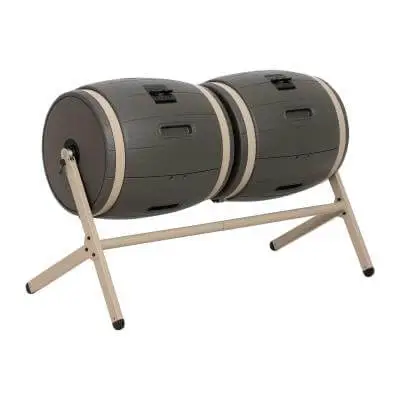
Compost bin tumblers are an excellent technique to create compost rapidly and easily. These dumpsters are totally sealed, making them ideal for eliminating smells and keeping pests at bay. They do, however, require regular turning to provide the optimum benefits, and they are also incredibly easy to turn. It is advisable to take it from the tumbler and lay it aside to complete the composting process. We have a blog totally based on tumbler composting, check that if you wanna know more about composting in a tumbler bin – Composting in a Tumbler.
Hot Bin Composter
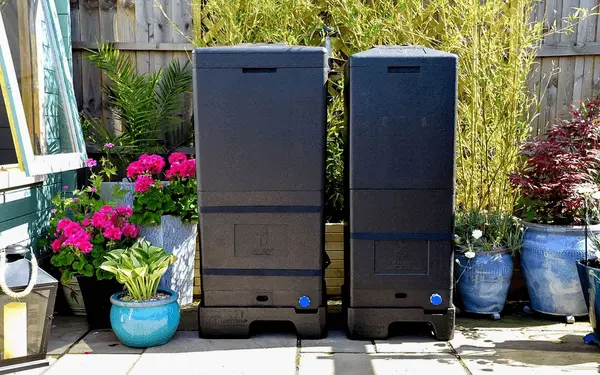
As suggested by the name, a hot bin composter uses heat to speed up the process of decomposition. Hot Bins are fully enclosed and contain a bin which can maintain good ventilation. These bins can maintain a temperature up to 140°F (60°C) which really creates a very good environment for the decomposition of the compost.
At such high temperatures, you don’t even have to worry about pathogens and bad bacteria as they die at such temperatures and the compost produced is very good.
Countertop Electric Composter
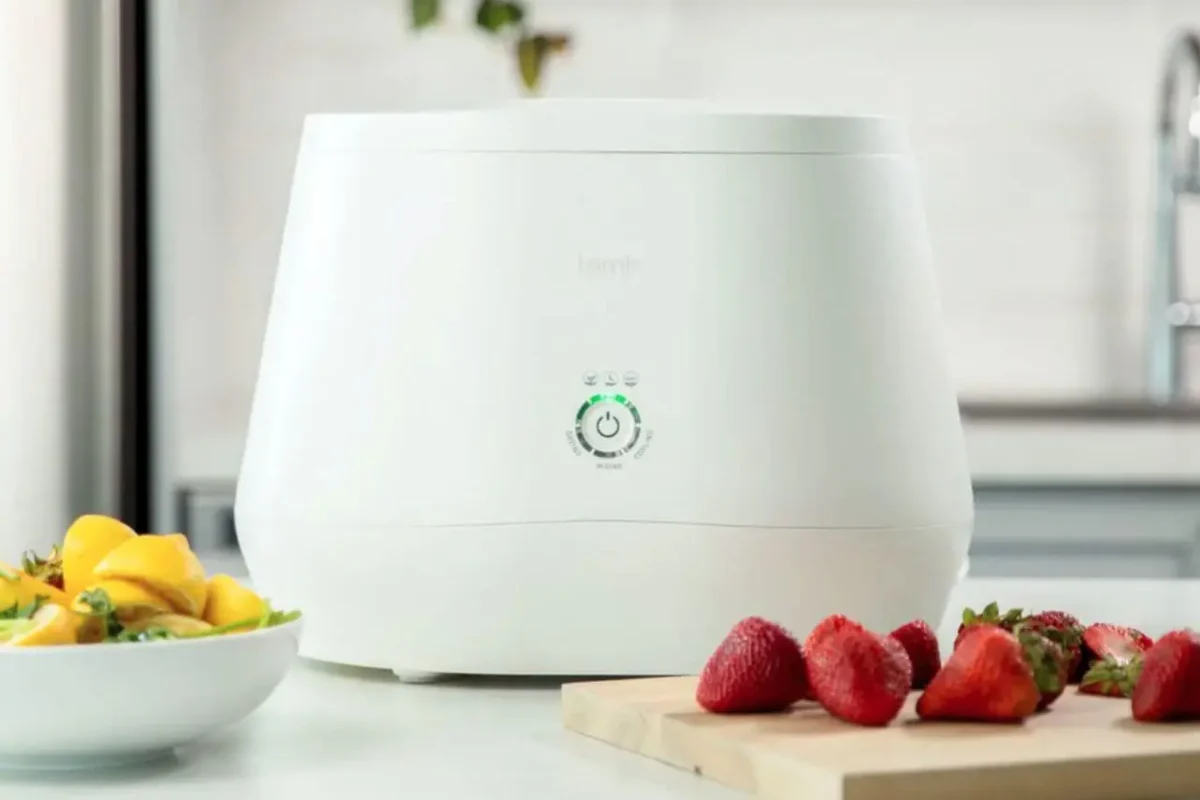
Have you ever heard of an electric composter? An electric composter is a kitchen appliance that turns your organic kitchen waste into nutrient-rich compost, providing you with fertilizer for your home garden. It usually takes around 3-5 hours for the automated cycle to finish and produce the compost – the amount of time depends on how much waste was put in and its wetness. With an electric composter, you can quickly and easily create valuable compost for your own garden!
Outdoor Composting Options
Outdoor composting methods, including compost tumblers or compost piles, can be adapted to concrete surfaces for larger-scale composting.
Brick Compost Heap
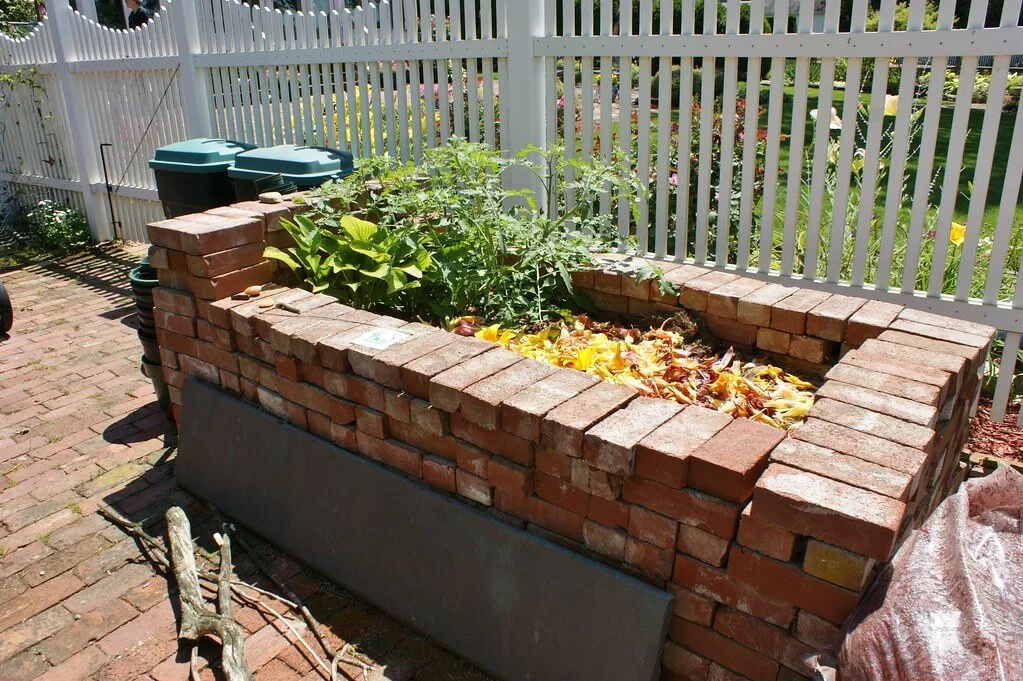
If you’re looking to start composting, consider building a brick compost heap. A brick compost heap is made up of bricks placed in a way that it makes an open box of it and you can then put your waste in it to decompose.This offers good insulation to maintain warmth and cosmetically look pleasing. However, there could be an issue with oxygen accessibility if the compost heap isn’t turned regularly and it may require more work to construct than other compost types and can’t be easily moved or removed later on.
Build a raised bed
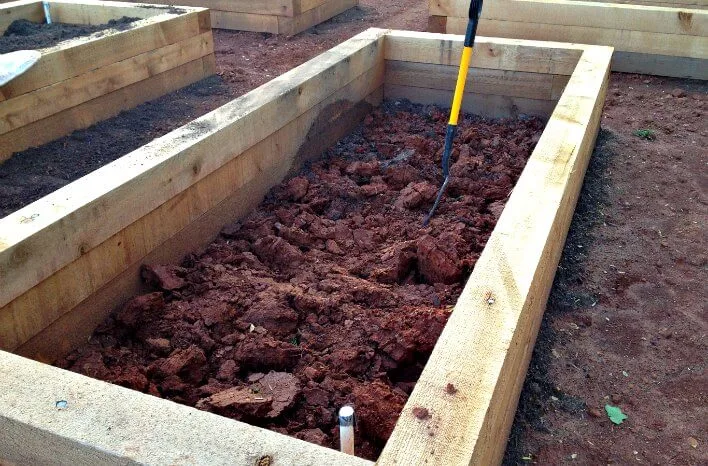
If you are looking to build a compost bed, then your best option is likely to be a raised bed. This will set your compost bin atop soil rather than concrete, allowing the liquid that runs out of the compost to enrich the soil around the bin. Raised beds can be easily bought, but they can also be crafted out of planks or sleepers with relative ease. You could even repurpose a palette, though it should be lined with plastic on the bottom if placed onto concrete for greater longevity and to prevent leaking into the ground. Additionally, red worms can greatly benefit any compost heap – Eisenia fetida in particular loves consuming decomposing material!
See this blog we wrote to know how you can make your own Brick Compost Bin: Making Brick Compost Bin for Composting
Dalek Bin
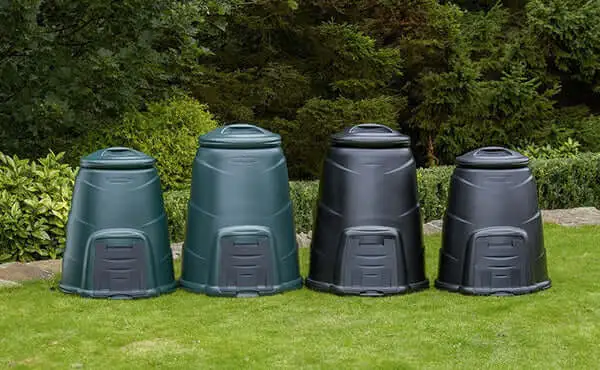
Dalek Compost Bin is a plastic bin that comes with a small covered opening at the botton through which you can extract the finished compost – though beware, as composting in a Dalek been isn’t as easy as you might think it is! Dalek bins are also ideal for people who don’t have a garden or living in a society. You can just put it in the corner of your balcony and prepare compost at your home. Know more about Composting with Dalek Bin
Vermicomposting (Using Worms)
Vermicomposting is a highly efficient method that utilizes worms to break down organic waste into nutrient-rich castings. It can be easily implemented on concrete surfaces.
Work of Worms in composting.
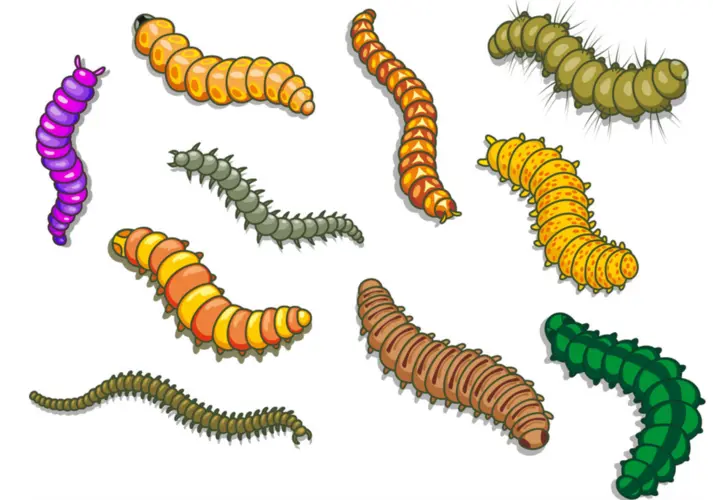
Did you know that an acre of soil can contain up to a million worms? These tiny invertebrates are essential in the transfer of organic matter from the surface to the underground. Worms help improve the fertility and structure of the soil, which is why they’re so widely used in gardening and farming practices. Plus, worms also help reduce waste and harmful bacteria as part of nature’s natural cycle!
Compost worms are the preferred type of worm to use in composting. These large and fat worms, different from earthworms, are also known as “red wrigglers” or “tiger worms”. Compost worms feed on decaying organic material, breaking it down and turning it into nutrient-rich soil suitable for gardening.
When composting is done on the ground, worms find their way to the compost through the soil and the presence of worms helps decompose the organic matter faster.
On the other hand, In order to get worms into a compost heap located on concrete, it may take some time for them to find their way in, or they might not even reach it. However, if they do, the worms can help break down organic material into nutrient-filled soil a little faster.
What type of worms should you add to your compost?
If you’re looking to add worms to your compost, you’ll likely get the best results from adding compost worms, specifically Eisenia fetida (also known as redworm or red wriggler, and the tiger worm). It’s important to note that worm activity can vary depending on the temperature – during colder months expect a slower rate at which they reproduce. If you are hot composting, don’t forget to wait for the compost to cool down before introducing more worms!
Bokashi Composting
Bokashi composting involves fermenting organic waste using a specific bran inoculated with beneficial microorganisms. It offers an odorless and compact composting solution for indoor spaces.
Selecting the Right Composting Materials
- Carbon-rich (Browns) and Nitrogen-rich (Greens) Materials: Balance the composting materials by incorporating a mixture of carbon-rich materials like dried leaves or straw and nitrogen-rich materials such as fruit scraps or grass clippings.
- Suitable Food Waste for Composting: Include vegetable and fruit scraps, coffee grounds, tea leaves, and crushed eggshells in your compost. Avoid meat, dairy products, oily foods, and non-organic waste.
- Avoiding Composting Materials that May Damage Concrete: Refrain from using materials like acidic citrus peels or plant debris that may degrade concrete surfaces.
Troubleshooting Common Issues
- Foul Odors and Solutions: Foul odors can result from improper aeration, excessive moisture, or the presence of inappropriate materials. Add dry carbon-rich materials, turn the pile more frequently, or adjust moisture levels to combat odors.
- Pests and How to Prevent or Manage Them: Common pests in composting include fruit flies, rodents, and ants. Prevent pests by burying fresh food waste and ensuring a balanced carbon-to-nitrogen ratio. Use pest-repellent measures if necessary.
- Excessive Moisture or Dryness: Adjust moisture levels by adding water or dry carbon-rich materials to achieve the optimal dampness for composting.
- Balancing the Compost Pile: Maintain a balanced ratio of carbon-rich and nitrogen-rich materials to prevent issues like slow decomposition or excess ammonia release.
Leaking Compost Heap

A compost heap is a type of composting system that usually involves throwing all kinds of organic matter into one big pile and allowing it to decompose. Although this method can be effective, they also require extra maintenance as it can get messy and cause discoloured liquid to leak out, potentially staining concrete or other surfaces and leaving a very bad smell behind. They may also require frequent turning over in order to speed up the decomposition process. If you’re looking for an easier way to compost without the fuss, it’s best to opt for a different method.
Bad Smell from the compost
While composting, the decomposition takes time and rotten organic matter releases gases which smell very bad and thus it pollutes the environment. If you’re composting in your apartment, make sure you use a balcony or a place that you don’t visit often and compost can remain untouched for weeks.
While composting on the ground is usually done away from the place where you live making you safe from the bad smell. However, if your compost smells bad, you can read this article to discover more ways to get rid of bad smell: Why your compost stinks and 25 ways to get rid of bad smell
Harvesting and Using Compost
- Signs that Compost is Ready for Use: Compost is ready when it appears dark, crumbly, and earthy with no recognizable original materials. It should have a pleasant, earthy smell. Also See – Understanding Compost Maturity: Know When Your Compost is Ready
- Harvesting Compost from the Concrete Setup: Harvest compost by removing the finished compost layer from the bottom or side of the composting container or by sifting the compost to separate it from any remaining organic matter.
- How to Apply Compost to Plants and Gardens: Incorporate compost into garden beds by mixing it into the soil or using it as a top dressing around plants. Compost tea can also be made by steeping compost in water for use as a liquid fertilizer. Also see – How to Use Compost Properly.
Tips for Successful Composting on Concrete
- Monitoring and Adjusting the Composting Process: Regularly monitor the composting process by checking moisture levels, temperature, and the decomposition progress. Adjust as needed to optimize conditions.
- Composting in Different Weather Conditions: Account for weather conditions by adjusting moisture levels, covering the compost pile during heavy rainfall, or insulating the composting system during cold weather.
- Composting with Limited Space: Utilize space-saving composting methods such as worm bins or vertical composting systems for efficient composting in constrained areas.
Sustainability and Environmental Benefits of Composting
- Reducing Landfill Waste and Greenhouse Gas Emissions: Composting diverts organic waste from landfills, where it would release harmful methane gas, a potent greenhouse gas.
- Improving Soil Health and Fertility: Compost enriches soil with organic matter, enhances its structure, and promotes beneficial microbial activity, leading to healthier and more productive plants.
- Conserving Water and Reducing the Need for Chemical Fertilizers: Compost improves water retention in soil, reducing the need for frequent irrigation. It also supplies plants with essential nutrients, reducing reliance on synthetic fertilizers.




